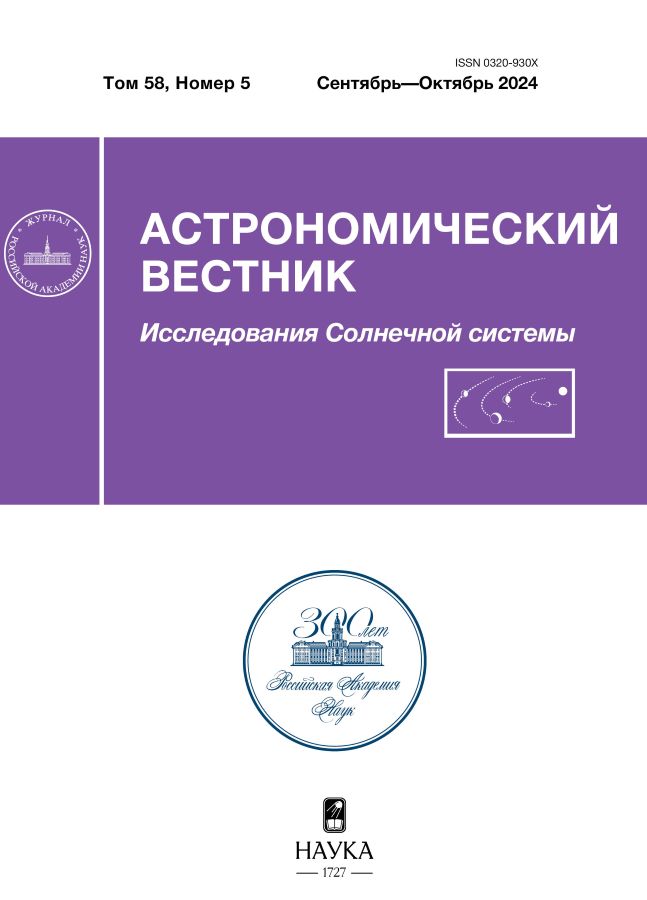Смещение фотоцентра в позиционных наблюдениях активных астероидов (6478) голт и (248370) 2005 qn173/433р
- 作者: Павлов С.Р.1, Чернетенко Ю.А.1
-
隶属关系:
- ИПА РАН
- 期: 卷 58, 编号 5 (2024)
- 页面: 599-607
- 栏目: Articles
- URL: https://ter-arkhiv.ru/0320-930X/article/view/648549
- DOI: https://doi.org/10.31857/S0320930X24050072
- EDN: https://elibrary.ru/LTISJV
- ID: 648549
如何引用文章
详细
Активные астероиды – это астероиды Главного пояса с физическими проявлениями кометной активности, выражающейся в значительном изменении блеска объекта, наблюдении комы и хвостов. В связи с этим возникает вопрос о том, требуют ли эти тела более сложного подхода при уточнении орбитальных параметров по сравнению с обычными астероидами. В данной работе мы провели серию уточнений параметров орбит активных астероидов (6478) Голт и (248370) 2005 QN173/433Р как с учетом негравитационных ускорений (НУ), что принято для комет, так и без них. На интервалах времени, совпадающих с периодами активности рассматриваемых астероидов, мы обнаружили статистически значимые систематические уклонения в остаточных разностях между наблюденными и вычисленными значениями в позиционных наблюдениях данных тел, (О–С). В результате проведенной работы мы выяснили, что учет негравитационного ускорения по модели Марсдена не приводит к улучшению представления наблюдений. В работе также рассмотрено предположение о наличии в наблюдениях смещения фотоцентра (СФ), т.е. несовпадения центра тяжести тела и центра яркости. Полученная величина смещения фотоцентра в сторону от Солнца для астероида (6478) составляет 985 ± 54 км, а для астероида (248370) –1145 ± 119, что примерно соответствует размерам сфер Хилла соответствующих тел. Учет СФ позволяет для (248370) устранить, а для (6478) существенно уменьшить систематические уклонения в остаточных разностях.
全文:
作者简介
С. Павлов
ИПА РАН
编辑信件的主要联系方式.
Email: sr.pavlov@iaaras.ru
俄罗斯联邦, Санкт-Петербург
Ю. Чернетенко
ИПА РАН
Email: cya@iaaras.ru
俄罗斯联邦, Санкт-Петербург
参考
- Мохнач Д.О. Распределение видимой плотности в голове кометы и его влияние на определение элементов орбиты // Бюлл. ИТА. 1956. Т. 6. № 5. C. 269–311.
- Buttner H. Die Bahn des Kometen 1853 III // Astron. Nachr. 1918. V. 207. P. 179–182.
- Devogèle M., Ferrais M., Jehin E., Moskovitz N., Skiff B., Levine S., Gustafsson A., Farnocchia D., Micheli M., Snodgrass C., and 15 co-authors. (6478) Gault: Physical characterization of an active main-belt asteroid // Mon. Notic. Roy. Astron. Soc. 2021. V. 505. P. 245–258.
- Chandler C., Kueny J., Gustafsson A., Trujillo C., Robinson T., Trilling D. Six years of sustained activity from active asteroid (6478) Gault // Astrophys. J. Lett. 2019. V. 877. id. L12.
- Chandler C.O., Trujillo C.A., Hsieh H. Recurrent activity from active asteroid (248370) 2005 QN173: A main-belt comet // Astrophys. J. Lett. 2021. V. 922. id. L8.
- Hsieh H., Chandler C.O., Denneau L., Fitzsimmons A., Erasmus N., Kelley M.S.P., Knight M.M., Lister T.A., Pittichová J., Sheppard S.S., and 10 co-authors. Physical characterization of Main-belt comet (248370) // Astrophys. J. Lett. 2021. V. 922. id. L9 (10 p.).
- Hui Man-To, Jewitt D. Non-gravitational acceleration of the active asteroids // Astron. J. 2017. V. 153. id. 80 (9 p.).
- Hui Man-To, Kim Y., Gao X. New active asteroid (6478) Gault // Mon. Notic. Roy. Astron. Soc. Lett. 2019. V. 488. № 1. P. L143–L148.
- Jackson P.M., Nakano R., Kim Y., Hirabayashi M. Active Main-belt asteroid (6478) Gault – Constraint on its cohesive strength and the fate of ejected particles in the Solar System // https://arxiv.org/pdf/2112.11582.pdf. 2021. 14 pp.
- Jewitt D. The Active Asteroids // Astron. J. 2012. V. 143. № 3. id. 66. (14 p.).
- Jewitt D., Hsieh H., Agarwal J. The Active Asteroids // Asteroids IV / Eds: Michel P., DeMeo F., Bottke W. Univ. Arizona, 2015. P. 221–241.
- Jewitt D., Kim Y., Luu J., Rajagopal J. Episodically active asteroid 6478 Gault // Astrophys. J. Lett. 2019. V. 876. № 2. id. L19.
- Everhart E.A. Implicit single sequence methods for integrating orbits // Celest. Mech. 1974. V. 10. P. 35–55.
- Lister T., Kelley M.S.P., Holt C.E., Hsieh H.H., Bannister M.T., Verma A.A., Dobson M.M., Knight M.M., Moulane Y., Schwamb M.E., and 25 co-authors. The LCO outbursting objects key project: Overview and year 1 status // Planet. Sci. J. 2022. V. 3. № 7. P. 173.
- Luu J., Jewitt D., Mutchler M., Weaver H.A. Rotational mass shedding from asteroid (6478) Gault // Astrophys. J. Lett. 2021. V. 910. id. L27.
- Marsden B.G., Sekanina Z., Yeomans D.K. Comets and nongravitational forces. V // Astron. J. 1973. V. 78. P. 211.
- Medvedev Yu.D. Dust cloud in the comet head and its possible connection to the photocentre shift phenomenon // Proc. Second Int. Workshop on Positional Astronomy and Celestial Mechanics held at Valencia. Spain, 1993. P. 106–117.
- Moreno F., Jehin E., Licandro J., Ferrais M., Moulane Y., Pozuelos F.J., Manfroid J., Devogèle M., Benkhaldoun Z., Moskovitz N., and 4 co-authors. Dust properties of double-tailed active asteroid (6478) Gault // Astron. and Astrophys. 2019. V. 624. id. L14.
- Novakovic B., Pavela D., Hsieh H.H., Marceta D. Photometric and dynamic characterisation of active asteroid (248370) 2005QN173 // Mon. Notic. Roy. Astron. Soc. 2022. V. 516. P. 757–765.
- Park R.S., Folkner W.M., Williams J.G., Boggs D.H. The JPL planetary and lunar ephemerides DE440 and DE441 // Astron. J. 2021. V. 161. P. 105–119.
- Purdum J.N., Lin Z.-Yi, Bolin B.T., Sharma K., Choi P.I., Bhalerao V., Hanuš J., Kumar H., Quimby R., van Roestel J.C., and 42 co-authors. Time-series and phase-curve photometry of the episodically active asteroid (6478) Gault in a quiescent state using APO, GROWTH, P200, and ZTF // Astrophys. J. Lett. 2021. V. 911. № 2. id. L35 (16 p.).
- Vereš P., Farnocchia D., Chesley S.R., Chamberlin A.B. Statistical analysis of astrometric errors for the most productive asteroid surveys // Icarus. 2017. V. 296. P. 139–149.
补充文件











